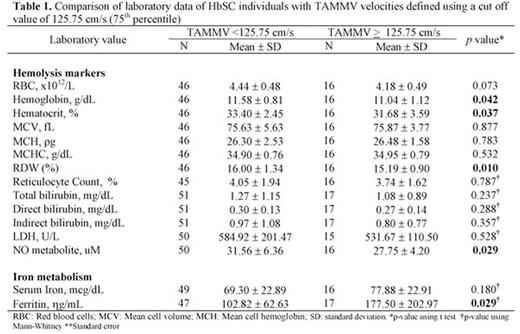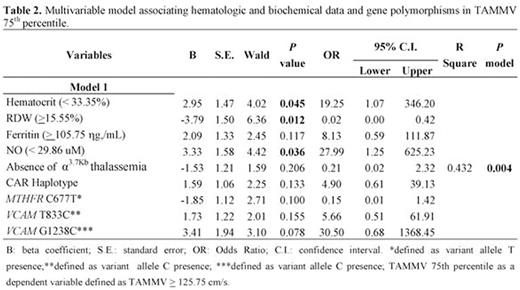Abstract
INTRODUCTION: Clinical complications in hemoglobin SC disease (HbSC) are mild compared to sickle cell anemia (SCA), the most severe type of sickle cell disease. However, HbSC individuals have 100 times greater risk of stroke compared to the healthy population. The lack of studies to determine reference values for transcranial Doppler (TCD) velocities in HbSC is still a limitation considering that we have been used TCD velocities previously determined for the SCA and having as standard the one described by Adams et al. (1992). Other studies described cerebral blood flow velocities (CBFV) for HbSC individuals, and considered as abnormal values that exceed 128 cm/s and 143.5 cm/s respectively. Studies show the association of abnormal TCD with distinct laboratorial biomarkers, despite the controversial results. To our knowledge, there are no published studies based on specific biomarkers and abnormal CBFV for HbSC individuals. Thus, we aim to investigate the association of genetic, hematological and biochemical data with CBFV in HbSC.
METHODS: A cross-sectional study comprising 68 HbSC individuals, with an average age of 6.96 ± 3.90 years, whom 40 (58.82 %) were female, attended the Pediatric Cerebrovascular Disease Outpatient Center at the Hospital Universitario Professor Edgar Santos (HUPES) of the Universidade Federal da Bahia (UFBA) was conducted. All procedures were in accordance with the 1964 Helsinki declaration and its later amendments. The CBFV was estimated with TCD, and the time-averaged maximum mean velocity (TAMMV) in the middle cerebral arteries, anterior cerebral artery and distal intracranial internal carotid was assessed. Hematological and biochemical parameters, nitric oxide (NO) measurement and genetic polymorphisms in methylenetetrahydrofolate reductase (MTHFR) 677C>T (rs1801133), vascular cell adhesion molecule (VCAM)-833T>C (rs1041163)and VCAM 1238G>C genes, α3.7Kb thalassemia (-α3.7-thal) and Beta S (βS) haplotypes were investigated. Statistical analyses were performed using SPSS version 18.0 software, Graphpad Prism version 6.0 and JMP software. P values <0.05 were considered significant.
RESULTS: The median of TAMMV in the HbSC individuals was 111.50 cm/s, the 25th percentile was 101.50 cm/s and the 75th percentile was 125.75 cm/s. The TAMMV was negatively correlated to red blood cells (RBC) (R= -0.2734; P= 0.0315), hemoglobin (Hb) (R= -0.3390; P= 0.0070), hematocrit (Ht) (R= -0.3470; P= 0.0057) and direct bilirubin (R= -0.2545; P= 0.0363) and positively correlated to monocytes (R= 0.2533; P= 0.0470) and ferritin (R= 0.3044; P= 0.0145). Based on previous protocol for SCA established by Adams and colleagues, we found two individuals with low TCD, 64 with normal TCD, one with abnormal TCD and one with inconclusive TCD. Noteworthy, this classification is not suitable for HbSC individuals. Using a cut off value of 128 cm/s, defined by Deane and colleagues (2008), we found significant decreased RDW (p=0.035) and NO (p=0.017) values in HbSC individuals with TAMMV higher than 128 cm/s. Vieira and colleagues (2014) defined a cut off value of 143.50 cm/s for HbSC individuals in the same population of this study. We found significant decrease of Hb (p=0.008) and Ht (p=0.008) concentration and increased ferritin levels (p=0.023) in HbSC individuals with TAMMV higher than 143.50 cm/s. Value of TAMMV at 75th percentile (125.75 cm/s) was used in order to evaluate the laboratorial markers. We found significant differences in Hb, Ht, RDW and NO levels, which were decreased, and in the ferritin, which was elevated in HbSC individuals with TAMMV above 125.75 cm/s (Table 1). The multivariate analysis adjusted by age and sex showed that Ht (< 33.35%), RDW (> 15.55%) and NO (< 29.86 uM) were independently associated with TAMMV values higher than 125.75 cm/s (75th percentile) (Table 2).
CONCLUSIONS: We suggest that RBC, Hb, Ht, RDW, monocyte, direct bilirubin, NO, ferritin, polymorphism on the MTHFR 677C>T gene and the absence of α3.7Kb thalassemia are associated with TAMMV on HbSC individuals. The TAMMV 125.75cm/s is lower than the those proposed by Deane et al. (2008) and Vieira et al. (2014), but have shown to be associated with hematological and biochemical changes found in both velocities 128 cm/s and 143.50 cm/s respectively. Thus, we also suggest that TAMMV of 125.75 cm/s should be investigated in additional studies as a cut-off point for stroke risk in HbSC individuals.
No relevant conflicts of interest to declare.
Author notes
Asterisk with author names denotes non-ASH members.



